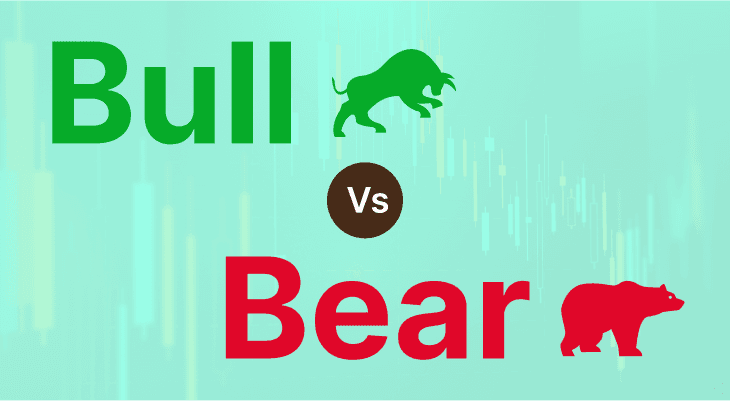
Table of content
- Decoding Bullish and Bearish Markets
- Indicators of Bullish Market Sentiments
- Strategies for Navigating a Bull Market
- Indicators of Bearish Market Sentiments
- Strategies for Navigating a Bear Market
- Unveiling the Distinct Characteristics: Bull Market vs Bear Market
- Understanding Similarities
- Strategies for Bull vs Bear Market Investing
- Tips for Navigating Bull and Bear Markets Successfully
- Conclusion
Bull vs Bear Market: What are the Differences?
The phrases "bear" and "bull" in the financial world refer to opposing forces that influence the market's emotions and direction, not merely animals. A bear market denotes fall and pessimism, whereas a bull market represents optimism and expansion. Let's set out to comprehend these bull and bear market differences and identify the most important distinctions between them.
Decoding Bullish and Bearish Markets
Imagine the stock market as a thriving market where investors come to purchase and trade shares. The Bull and the Bear are the two main forces that set the pace in this busy field. A bull market is defined as a time of optimism and rising momentum, during which stock values rise and investors project assurance. In contrast, a bear market depicts a negative image of a decline in the economy, with falling stock values and decreasing investor confidence.
Indicators of Bullish Market Sentiments
There are obvious signs that people are optimistic about the economy in a bull market. The following are some crucial signals:
GDP Growth
An increase in a nation's GDP (Gross Domestic Product) indicates higher consumer spending, which is good news for the economy in a bull market. The success of businesses motivates investors to purchase stocks.
Increase In Stock Price
During a bull market, stock values rise gradually. Investor confidence and optimism on the market's future are bolstered by this. An increase in stock prices encourages more individuals to invest, which drives up the price even more.
More Jobs
A bullish market is also characterised by an increase in the number of job openings. In a booming economy, companies grow and add staff to keep up with demand. The increase in employment is a sign of economic expansion and boosts the market's optimism.
These signs are crucial in helping investors recognise a bull market. Recognising these indicators enables investors to seize the chances created by a bullish market climate and make well-informed selections.
Strategies for Navigating a Bull Market
Amid a bull market, investors need to exercise caution and use wise strategies:
Emphasise Growth-Oriented Investments
Take advantage of the positive outlook in the market by concentrating on growth-oriented assets, such as small-cap stocks and growth stocks, which are expected to do well during economic expansion.
Sector Rotation
Take advantage of the variety of chances that arise from different industry performances by strategically shifting investments among sectors that are expected to expand.
Indicators of Bearish Market Sentiments
Several concerning signs emerge when the financial landscape becomes impacted by negative winds:
High Unemployment
High unemployment rates are a symptom of economic confusion since they cause company losses and mass layoffs, which clouds the market.
Fall In Stock Prices
As investor confidence declines during a bear market, stock prices plunge, which worsens the market's downturn through a chain reaction of selling pressure.
Temporary Nature Of Bear Markets:
Bear markets are temporary; despite the general doom, they frequently give way to a resurgence of market resiliency and recovery.
Strategies for Navigating a Bear Market
Investors need to take a protective approach when negotiating the risks of a bear market:
Preserve Capital
By giving priority to safe-haven assets like bonds and gold, which provide stability in the face of market volatility, you can protect your capital from the storm.
Dividend Stocks
Take cover from falling asset values with dividend-paying equities, which offer a consistent income source throughout market volatility.
Hedging Strategies
Use hedging strategies to reduce portfolio risk and use financial instruments to protect against market downturns, such as inverse ETFs or options.
Unveiling the Distinct Characteristics: Bull Market vs Bear Market
To differentiate between bull and bear markets, it is necessary to examine their distinct features in further detail.
Characteristic | Bull Market | Bear Market |
|---|---|---|
| Market Sentiment | Optimistic and Positive | Pessimistic and Negative |
| Investor Behaviour | Buy and Hold | Sell and Exit |
| Investment Styles | Growth Stocks, Aggressive Trading | Defensive Stocks, Value Investing |
| Risk Appetite | High | Low |
| Economic Indicators | Low Unemployment, Rising GDP | High Unemployment, Declining GDP |
| Asset Performance | Appreciation Across Asset Classes | Decline Across Asset Classes |
| Volatility | Lower Volatility, Smoother Trends | Higher Volatility, Frequent Swings |
| Market Psychology | Confidence and Enthusiasm | Fear and Caution |
| Market Impact on Employment | Increased Hiring | Job Cuts and Layoffs |
Understanding Similarities
Even while bull and bear markets symbolise completely different market attitudes, they have a few things in common:
Investor Sentiment
Investor sentiment, which reflects the general attitude and level of confidence in market circumstances, affects both markets.
Economic Cycles
The bull and bear markets, which are inherent to the economic cycle, are distinguished by unique patterns and circumstances.
Prospects For Investors
Regardless of the mood of the market, there are chances for investors to profit from shifts in the market, even if they will be utilising various investing approaches.
Market Corrections
Both bear and bull markets experience corrections, whereby bear markets adjust downward and bull markets occasionally experience setbacks before turning back upward.
Effect On Asset Classes
Different asset classes are affected differently by bull and bear markets, which encourages investors to diversify their portfolios to reduce risk and take advantage of any profits.
Strategies for Bull vs Bear Market Investing
Investing In A Bull Market
Prioritise Growth-Oriented Investments
Make the most of economic growth by giving growth-oriented assets top priority.
Sector Rotation
To optimise profits, rotate investments among industries that are expected to expand.
Purchase The Dip
Consider market declines as chances to acquire assets at a reduced cost.
Long-Term Investment Strategy
To profit from steady market expansion, and have a long-term outlook.
Investing In A Bear Market
Preserve Capital
Put safe assets first, such as defensive stocks and bonds, to protect your capital.
Dividend Stocks
In times of market turbulence, seek solace in dividend-paying companies to ensure a consistent flow of income.
Hedging Strategies
Use hedging strategies to reduce portfolio risk and protect against market declines.
Rupee-Cost Averaging
Make consistent investments to reduce average investment costs in the face of market volatility.
Tips for Navigating Bull and Bear Markets Successfully
These essential pointers will help investors navigate the uncertain waters of bull and bear markets as they make their way there:
Asset Allocation And Diversification
Distribute your assets among a variety of asset types to reduce risk and meet your long-term financial objectives.
The Value Of Long-Term Vision
To weather market turbulence and take advantage of compounding gains over time, stay laser-focused on long-term goals.
Avoid Making Emotional Decisions
Avoid making hasty judgements that are motivated by feelings and instead follow a methodical investing strategy based on reliable financial information.
Conclusion
Equipped with information and insight, investors set out on a journey full of chances and obstacles as they navigate the complex terrain of bull and bear markets. Through the ability to distinguish minute differences between these market giants, the use of effective investing techniques, and the constant concentration on long-term goals, investors may confidently and resiliently sail the uncertain waters of finance. Remember that the secret to success is to pursue your financial goals while remaining prudent and persistent in your adaptation to market conditions.
FAQ
Which tactics are appropriate in a bull market?
Using a 'buy and hold' approach can provide substantial gains during a bull market. Additionally, you may profit from the rising momentum by diversifying your portfolio and keeping up with market developments.
In what ways may investors safeguard their holdings in a down market?
During periods of market recession, protecting your investments becomes crucial. Think about shifting funds to defensive industries like healthcare and utilities. Additionally, looking into fixed-income options like bonds and Treasury bills might offer a safe haven during volatile market times.
For what duration do bull and bear markets usually last?
The length of bull and bear markets can differ greatly, spanning from a few months to many years. Bear markets often last shorter times but have a more powerful impact than bull markets, which are defined by protracted times of optimism and prosperity.
Is mood in the market able to affect the change from bull to bear markets?
Yes. The way that the market feels during a transition between a bull and a bear market is crucial. Irrational excitement may encourage the Bull's rise during euphoria, while widespread fear and uncertainty could accelerate the Bear's decline.


